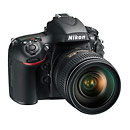 Update: In spite of my skepticism about the Nikon D800’s high resolution 36-megapixel sensor, my concerns have mostly been squashed. First, it turns out that the image quality is excellent – about as good as it gets, in fact. Since I first wrote this intro article, image quality testing site DxO Mark gave the D800 their highest rating ever and the photography community has had nothing but good things to say about the D800. Check out our Nikon D800 studio sample photos page to judge the image quality for yourself. Second, Nikon also introduced a lower resolution full-frame camera this year, the 24-megapixel D600, providing an alternative for photographers who don’t want or need a 36-megapixel sensor. I still consider the D800 a specialty camera because of its high-resolution. Although it’s excellent for landscape, studio and commercial photographers, most people just don’t need that kind of resolution. Personally, I think the sweet spot for a good balance between speed, file size and image quality is 16 to 18 megapixels. That said, the popularity of the D800 and its excellent image quality are proof that Nikon was on-target with the D800.
Update: In spite of my skepticism about the Nikon D800’s high resolution 36-megapixel sensor, my concerns have mostly been squashed. First, it turns out that the image quality is excellent – about as good as it gets, in fact. Since I first wrote this intro article, image quality testing site DxO Mark gave the D800 their highest rating ever and the photography community has had nothing but good things to say about the D800. Check out our Nikon D800 studio sample photos page to judge the image quality for yourself. Second, Nikon also introduced a lower resolution full-frame camera this year, the 24-megapixel D600, providing an alternative for photographers who don’t want or need a 36-megapixel sensor. I still consider the D800 a specialty camera because of its high-resolution. Although it’s excellent for landscape, studio and commercial photographers, most people just don’t need that kind of resolution. Personally, I think the sweet spot for a good balance between speed, file size and image quality is 16 to 18 megapixels. That said, the popularity of the D800 and its excellent image quality are proof that Nikon was on-target with the D800.
The boat this camera came in on must have sunk as soon as it reached the harbor because it was a seriously leaky vessel. However, you never know how much of what the rumor sites say is true until the announcement is official. Well, the Nikon D800 “Multimedia HD-SLR” is now official. The rumors were actually pretty much right on target this time. In a departure from previous strategy, the D800 gets a totally new, Nikon-designed 36.3-megapixel FX-format CMOS sensor. The positioning of the D800 is very similar to that of the D700. It’s a more affordable full-frame camera than the new Nikon D4 and it inherits a lot of the same technology but without the speed or battle-worthy build. The D800 has the same 51-point auto focus system and EXPEED 3 image processing as the D4, 1080p HD Video, 3.2-inch 921k-dot LCD display – it even gets Nikon’s new 91k-pixel 3D Color Matrix Metering III system and corresponding Advanced Scene Recognition System. Where the D800 diverges from the D700 strategy is resolution. Instead of offering the same number of pixels as the D4, the D800 more than doubles the resolution of the D4 and triples the resolution of the D700. And of course, unlike the D700, which had no video capability, the D800 gets full HD video with a lot of pro-level perks, including manual exposure control.
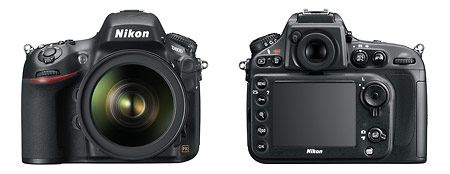
The D800 has been one of the most-anticipated digital SLRs Nikon has ever introduced. It’s been almost 4 years since the D700 was announced (August, 2008) and speculation on the final features and specs have been going on for a couple of years now. Now that it’s public, I’ll be curious to see what the photography community thinks. Is the high-resolution sensor something the majority wants or not? I spoke to one photographer a couple of days ago who said he wasn’t interested in a super high-res sensor and that he needed more speed than he thought the rumored (at the time) Nikon D800 was going to offer. I think he will be happy to find out that the D800 is actually capable of bursts as fast as 6 frames per second if you use the new MB-D12 battery pack. Without the battery pack, the D800 can shoot 4 frames per second. That’s actually pretty damn good for a camera with a 36-megapixel sensor. Those are going to be some huge RAW files! For photographers who already own Nikon DX-format (APS-C sensor) cameras and lenses, the D800 also has a DX-format mode so you can use all your lenses. In DX crop mode, the D800 captures 15.4-megapixel images and the burst rate is increased to 5 frames per second.
Nikon D800 Key Features & Specs:
- Nikon-designed 36.3-megapixel FX format (full-frame) CMOS sensor
- EXPEED 3 image processing
- The same 51-point auto focus system as the D4
- AF detection down to -2 EV with all AF-Nikkor lenses
- Sensitivity from ISO 100 to 6400, expandable to ISO 50 and ISO 25,600 (Hi-2)
- 91,000 pixel 3D Matrix Metering system
- 2-axis electroninc level
- Built-in adjustable HDR mode
- 4 frames per second burst (6 frames per second possible with MB-D12 battery pack)
- 3.2-inch 921k-dot LCD display
- 1080p HD video at 30 or 24 frames per second and 60 FPS at 720p
- Full manual exposure control in video mode
- Live, uncompressed output via HDMI port
- Stereo headphone jack, stereo mic jack and 30-step in-camera audio levels control
- Full time auto focus in video mode
- Built-in intervalometer with in-camera with in-camera time-lapse video output
- 100% coverage optical viewfinder
- Built-in pop-up flash (can be used in Commander Mode)
- SD and CompactFlash memory card slots
- Weather-sealed magnesium alloy body
- USB 3.0 interface
- Price: $2999.95
The new 36-megapixel sensor was made with landscape, commercial, wedding and portrait photographers in mind. With a resolution of 7360 x 4912 pixels, it’s going to deliver medium format-level resolution. That means crazy wedding dress detail, every leaf and blade of grass clear and sharp in landscape mural prints, and arguably too much detail for portraits – no one wants to see their pores and zits that well, right? But there’s definitely a big market for a high-resolution camera like this.
But it’s not all about resolution now is it? There’s a reason that Nikon kept the resolution low on their last few high-end digital SLRs. Lower resolution means less noise. But according to the Nikon folks who briefed me on the D800, in spite of the serious increase in resolution the noise levels remain the same in the D800 as they were in the D700 until you get all way up into the expanded sensitivity settings. I haven’t seen any sample photos so I can’t confirm that but if they managed to triple the resolution of the D700 and keep the noise the same, I think people are going to be very happy. I will be very impressed. On the other hand, there will be photographers who don’t want to deal with the extra storage and post-processing requirements that 36-megapixel image files demand.
The video success of the Canon EOS 5D Mark II, the D700’s direct competitor, has to be a long-term irritation to Nikon executives and product managers. Canon hasn’t replaced the 5D Mark II yet (at least not today, while I’m writing this article) and that gives Nikon a chance to get a leg up. They gave the D800 pretty much the same video specs as the D4, positioning it as an affordable alternative to the D4 for both still photographers and videographers, something they weren’t able to do last time around. And looking at the video features and specs, the D800 is probably going to be as big a deal to video guys as it is to still photographers. It’s got full HD video of course. Anything less is unthinkable these days. Frame rates are selectable with full 1920 x 1080 at either 30 or 24 FPS; and 30 or 60 FPS at 720p. The D800 uses H.264 compression enhanced by something called the “B-Frame data compression method.” I’m guessing video pros already know about this but it’s the first time I’ve heard of it. According to Nikon it makes the D800 able to produce cleaner video files with more detail without increasing the file size. Nikon also says the new sensor moves data faster resulting in less rolling shutter effect and the low light capability means you can record video in very low light without compromising quality.
If the H.264 B-Frame compression isn’t good enough, you can also use the D800’s HDMI port to bypass the in-camera processing by recording directly to a digital recorder. You can also use the HDMI port to display live video on an external video monitor. Some other significant video features are adjustable audio levels; a headphone jack with adjustable output; you can also use the DX-format crop for an effective 1.5x conversion while still recording at full HD resolution. And as I mentioned before, the D800 has full manual exposure control in movie mode. Nikon was also the first camera makers to introduce a digital SLR with continuous auto focus in movie mode and the D800 also has that capability.
Although the D800 isn’t really designed for action photographers it’s got the same 51-point auto focus system as the D4 with AF capable of performing at light levels as low as -2 EV. Theater and concert photographers, photojournalists, wedding and event photographers and anyone else who shoots moving subjects in low light will appreciate the improved auto focus. One of the main complaints about the Canon EOS 5D Mark II has been the poor auto focus performance. I don’t think Nikon D700 shooters had any issues and with the D800’s improved auto focus there shouldn’t be any reason to complain. Yes, the burst rate is slower, but like I said earlier, with the new MB-D12 battery pack the D800 can shoot as fast as 6 frames per second, really pretty quick and good enough for most action photography.
Nikon is actually going to make two versions of the D800 – the standard camera and the D800E, basically a D800 with no low-pass filter. The D800E will offer even better detail but at the cost of moiré. Commercial photographers who want the absolute maximum detail will pay $300 more plus some added post-processing to minimize the moiré. But that’s a small price to pay for a camera that, in theory, delivers medium format digital image quality in a standard DSLR-sized body and at a DSLR price.
The Nikon D800 will be available in late March at a suggested retail price of US $2999.95. The D800E should be available about a month later for $3299.95. If you want a D800 in any reasonable amount of time, I suggest getting a pre-order in right now as this camera is going to be ridiculously popular.
Nikon D800 Studio Sample Photos >>
Nikon D800 vs. Canon EOS 5D Mark III Intro Video >>
Nikon D800 Press Release >>
Related Content:
Nikon Digital SLR User Reviews
All Nikon User Reviews
All Digital SLR User Reviews
Nikon Cameras Forum
Digital SLR Forum
Digital Video Forum
More Nikon News And Articles
Nikon Web Site


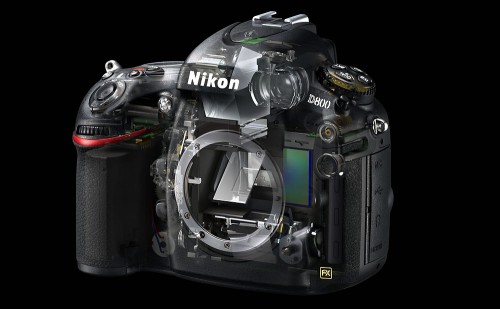
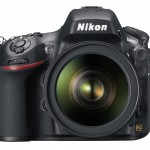
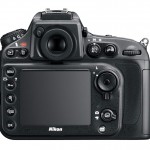
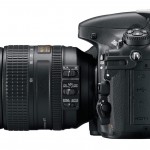
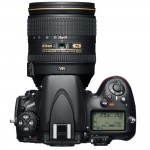
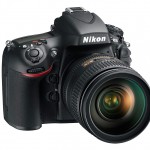
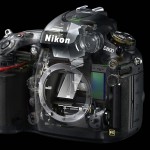
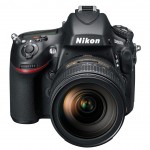
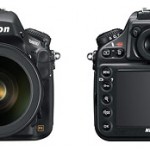
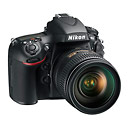
I’m excited to see images from the D800, but it’s pretty safe to say that shot through a stellar Nikon G lens the images are going to be really stunning. I bet a lot of pros are going to be wondering how it holds up against some medium format cameras. Could this be the poor man’s studio body? If it can go head to head with a Hassy then it could really make a lot of shooters happy. Obviously, wedding and portrait shooters are going to be excited about this as well.
I have a D700 body, I love it. I switched from a multiple body Canon kit to buy it and have not looked back but I’m not sure the D800 will work for me. Right now I shoot a lot of action and sports and I know this body just isn’t quite fast enough (The D700 goes 8fps with the vertical grip). I think my money might be better spent on a less expensive D7000 body that can do 6 FPS or just saving for the motherload 4D of my dreams. If I get more work doing studio or portrait work then the D800 might make better sense.
I use my D700 to create full page spread images in a large format sports magazine every month and it does that with aplomb. More megapixels can be beneficial, however three times the resolution can be a negative to those who work in a time dependent publishing schedule. If I buy a D800 I’m pretty sure that I’d ALSO need to get a computer with a faster processor and a larger storage drive or else my throughput is going to be affected. The usual 4-8 megapixel increase that we’ve been accustomed during an upgrade can typically be handled by the headroom in your workflow, however a three time increase in resolution is a little hard to stomach without some other hardware upgrades also.
The D800 is really exciting but I’m just don’t have the ‘have to have it’ feeling that the D700 gave me, given my current camera needs.
Thanks for the comment, Alan. I wondered what you were going to think about the D800. It’s faster than I think you expected. But you’re right, for the price, and with the added burden of larger files, for you, saving up for a D4 would be a better decision. But for wedding and purely commercial photographers, I think the D800 is a slam dunk for Nikon. I do wish it had selectable image sizes in RAW. I’m not 100% sure that it doesn’t but looking at the specs it doesn’t appear that it does.
My…….well if Canon does not announce a 1Ds X at 40+ MP. And I cannot afford a 645D for commercial/studio work one of these with a 50 prime may work for that.
I think I need a D4 and a D800 to cover everything I shoot. There has definitely been times when doing non-sports shoots that I have really needed more pixels to capture the images that I needed. For sports and most events though, it looks like the D800 is going to be major overkill in the file size department. I can’t even imagine editing 1000+ 36mp RAW files after an event — yikes! It would be cool if the D800 had selectable image size in RAW or tiff.
Just about everything that we were hoping for, including the price. Thanks Nikon.
Beautiful camera, impressive specs
I do not need it , but if I win the lottery I’ll buy it
I can’t believe they are releasing a 36mp camera… Looks like Nick at pictureline was wrong when he predicted that it would NOT be a 36mp camera. http://www.pictureline.com/blog/why-the-nikon-d700-replacement-wont-be-36-megapixels/ That aside it was just a prediction. I can’t wait to test it out.
I look forward to seeing pictures too. If the reviews are as good as I expect them to be, then I’m sure to get one by the end of the year (saving hard). I have a trip to the US in October so if I’ve saved enough I’ll buy one when I’m there, probably 30%-40% cheaper than here in Australia. I’d love to do more macro work and blow up shots so this would suite me fine, plus I’m quite liking studio work and portraits. I’m lucky to have the D3 so with both in hand I’m set for quite some time.
The price is a shocker… This camera is out of price for a lot of people… I wished it would have passed on 36 MP (who needs that, only high end magazines and such) since all of our computers will be too small, I have two drobo’s but hey, with 36 MP the storage required will be humonguous… The price is my biggest peeve though… Guess I will be stuck to my D300 because 3000 dollar is a lot of money… Can’t believe that people find this reasonable… Especially with stock photography in such a low situation… Another camera that only well selling pro’s can afford…
The penalty for 36MP appears to be dynamic range of the sensor. Why else would there be a single-press 2-shot exposure bracket with resulting images combined in camera? It’s very difficult to retain dynamic range and shrink the photosites that much at the same time. Give them a few years, maybe.
Might well be a fair enough exchange for the pixels but I guess a lot of landscape photographers are going to be bracketing exposures, even for ‘ordinary’ rather than explicitly HDR images.
For studio stuff with tightly controlled contrast range-not a problem. Like armando_m, the first call on a lottery win will be one!
I would have liked both the D4 and the D800 to replace my two D3′s. Bob Margolis is dead right, the price is a shocker. So I had to compromise. Upgraded to the D3′s (2 years warranty here in oz so that helped) and ordered the D800. Time will tell if i was right, I guess.
Technology is moving way too fast for me to keep up
I have purchased D800 and planning to attch the battery grip. Excellent Photography Great reak through by Nikon. I hope they do not dilute and manufacture lower quality
Vijay
Tata Consulting Engineers Bangalore